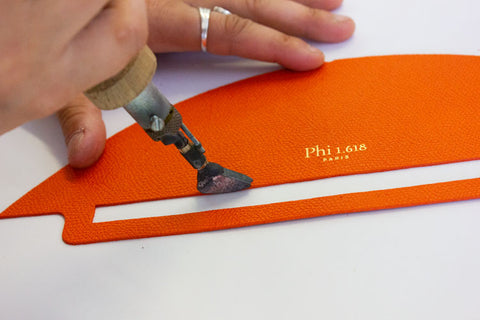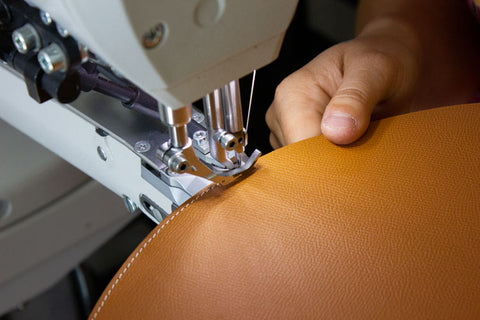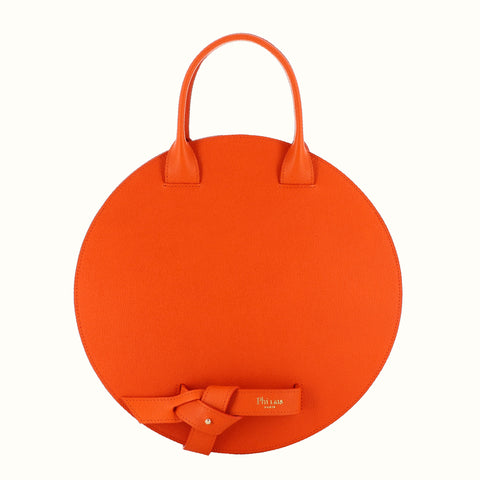The making of our Philo handbag
The realization of a handbag consists of a multitude of steps, from the idea to its materialization, from a leather skin to an accessory that we want to be a work of craftsmanship.

We reveal the secrets of our craftsmen and take you into the world of fine leather goods: discover our brand new handbag Philo, the little sister of Philomène.

Everything starts with the desire to create, always in the great course of (re)creation of the golden number. It is often our customers who inspire Juliette, the creator of Phi 1.618. She listens to their desires, their needs and from an exchange is born an idea.
For each new handbag, Juliette makes three prototypes to achieve the ideal result. Each prototype is tested, then optimized.
It is then entrusted to the workshop of art craftsmen in Touraine. A pre-production run is made to further optimize the model and allow it to be made in several types of leather, always full grain leather, but different textures, thicknesses, outfits (to discover here).
Here are the steps, once all the previous ones have been validated:
Cutting:
The first step is to cut out all the parts of the handbag. For Philo, this includes the two circular sides, the sides, the handles, the shoulder strap, and details such as the hand loop. In total, more than thirty pieces are subjected to this step, some of which are invisible, once the bag is finished.

The "saddler" finishes, our favorites:
This is the type of specific finish that Phi uses. They are the rarest. There are three signs that identify them: the threading, the "clean" and tinted edges, and the oblique stitching of each point of the seam that only the truly discerning eyes of a craftsman or someone familiar with luxury can notice.
Threading:
After cutting, some parts must be prepared before assembly because they will no longer be accessible afterwards.

Using the threading iron equipped with the double thread, a line is marked two millimeters from the edge. This is the signature of the bag. It can be decorative, but it also serves to bring together two pieces of leather that have been glued together in preparation for dyeing.
This operation is done while hot; the temperature of the iron is around 100°C and requires a firm hand from the craftsmen to accomplish it in one regular movement. The slightest slip is noticeable.
Dyeing :
Each raw edge of the bag is dyed to maintain its quality over time, to make it waterproof and to make it as pleasing to the touch and to the eye as possible. Depending on the location of the bag and the design to be dyed, several layers are applied, sometimes up to six! This process takes time and, because it is done by hand, is very precise.
Between coats, the edge should be heated and sanded to round and smooth it out in preparation for the next coat of stain.

Marking:
Our trademark, based on the golden ratio, is also affixed to each product. Using an embossing machine and gold foil, our artisans place the Phi 1.618 logo precisely where it is needed, along with the words "Made in France". They also number each bag because we make very limited series.

Sewing:
Some parts are sewn separately, the zipper and the pockets of the bag are placed on the inner sides before assembly. The part to attach the shoulder strap is fixed on the "channel" band, the one that goes around the bag on the side.
Once each part has been prepared, we assemble the handbag. Philo is machine sewn, which is very typical for items from the big luxury houses, and only the small details that cannot be assembled by machine are made by hand, such as the loop for the shoulder straps of our handbags.

Finishes:
Once the handbag is assembled, it must be "pampered". The last slices are then dyed. The hand loop is tied on the bag in the same way as our belts. And that's it! Philo is born!

All our handbags respect the golden ratio. Our Philomène piece inspired the creation of the Philo bag. Discover why Juliette Angeletti, the brand's designer, created it in a round shape.

